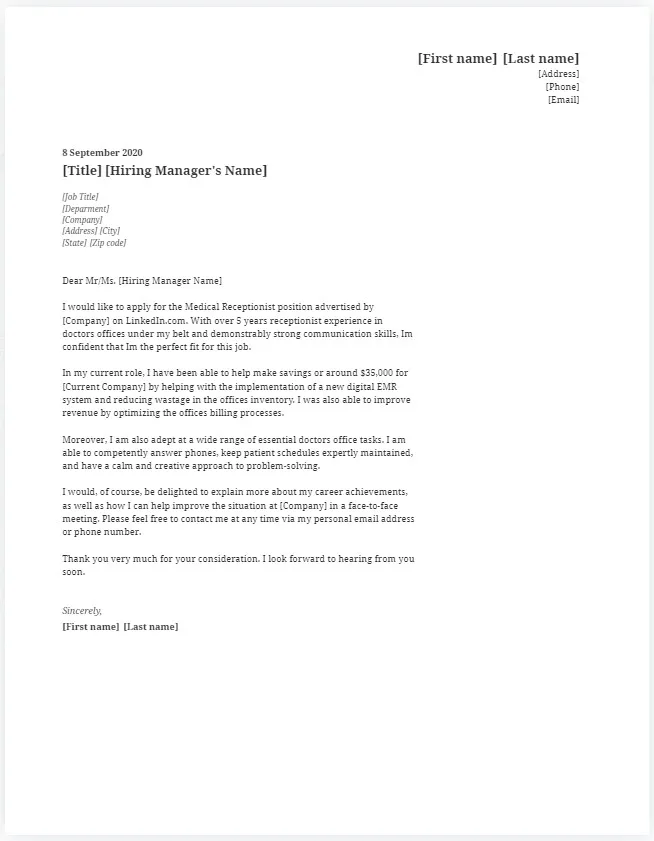The Importance of a Medical Receptionist Cover Letter
In the competitive field of healthcare, a well-crafted medical receptionist cover letter can be your key to unlocking the door to your dream job. It’s more than just a formality; it’s your first opportunity to make a strong impression and demonstrate why you’re the perfect fit for the role. Your cover letter acts as a bridge, connecting your skills, experience, and personality to the specific requirements of the position and the values of the healthcare facility. A compelling cover letter goes beyond simply restating your resume; it provides context, tells your story, and highlights what makes you stand out from other applicants. It showcases your writing skills, attention to detail, and your understanding of the medical field, all of which are essential qualities for a successful medical receptionist. Using a medical receptionist cover letter example can serve as a valuable guide, but remember to personalize it to make it your own.
Key Elements of a Strong Cover Letter
Contact Information and Salutation
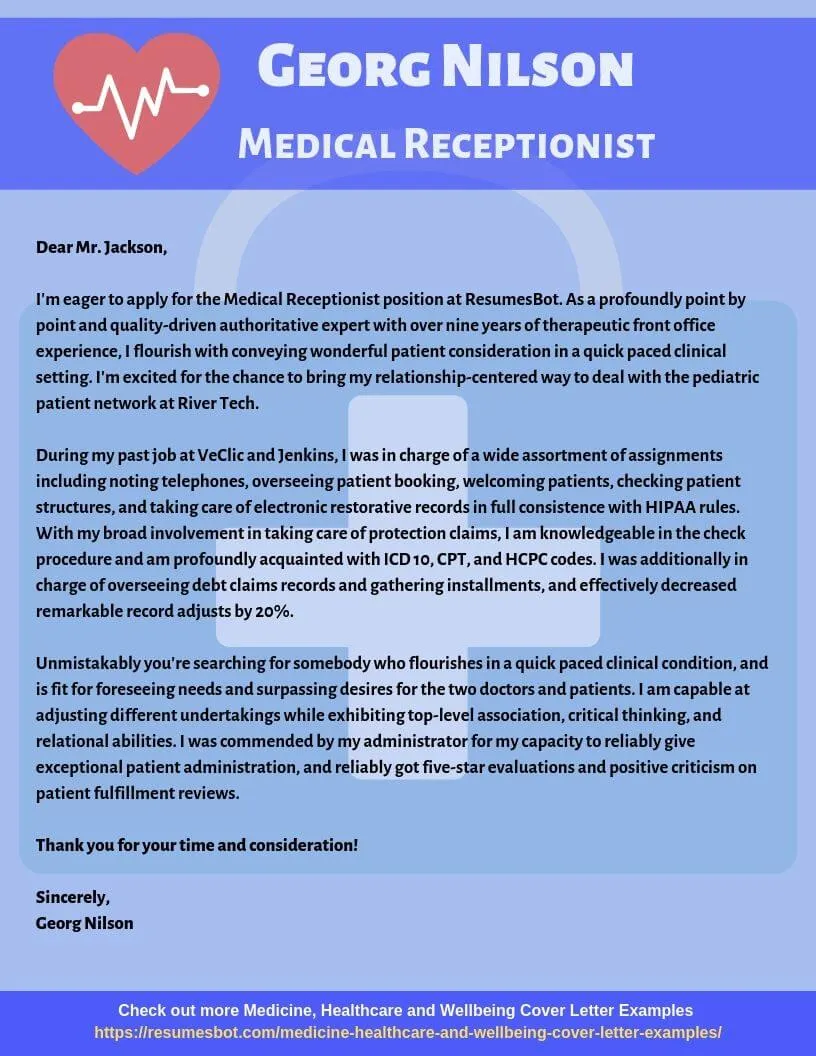
Start with your contact information at the top, including your name, phone number, email address, and optionally, your LinkedIn profile URL. Next, address the hiring manager directly if possible. Research the name of the person responsible for hiring; this shows initiative and attention to detail. Use a professional salutation like “Dear Mr./Ms./Mx. [Last Name]” or “Dear Hiring Manager,” if you can’t find a specific name. Avoid generic greetings such as “To Whom It May Concern,” as it can make your letter feel impersonal. Your professional contact information must be easily accessible for the employer. Consider including the date on your cover letter to help the employer identify it easily, which is one more way to show your attention to detail.
Highlighting Relevant Skills and Experience
This is where you showcase your abilities. Identify the skills most relevant to the medical receptionist role based on the job description. These typically include excellent communication, organization, appointment scheduling, patient interaction, and familiarity with medical software and insurance procedures. Don’t just list these skills; provide specific examples of how you’ve used them effectively in previous roles. Back up your claims with concrete evidence, highlighting your achievements and contributions in previous positions. The goal is to demonstrate how your capabilities align with the job’s requirements and how you can make a positive impact on the healthcare facility. The medical receptionist cover letter example should also include information on your past employment.
Experience Section
Describe your relevant experience, focusing on roles where you interacted with patients, managed schedules, handled phone calls, and processed medical records. Mention the healthcare settings you’ve worked in (e.g., clinics, hospitals, private practices). Use action verbs to describe your responsibilities and achievements. Instead of just stating you “answered phones,” say you “managed a high volume of calls efficiently and courteously, directing inquiries to the appropriate personnel.” This format helps hiring managers quickly grasp your experience and how it aligns with the job’s requirements. Always make sure to write about all your relevant experience and explain why they can be a good fit.
Skills Section

List specific skills that are vital for a medical receptionist. These can include proficiency in electronic health records (EHR) systems, patient scheduling software, and insurance verification. Be specific about your level of proficiency. For example, instead of stating “proficient in Microsoft Office,” write “proficient in Microsoft Office Suite, including Word, Excel, and Outlook.” Add skills like data entry, problem-solving, and multitasking abilities to your list. Highlighting technical abilities, along with soft skills like communication and empathy, provides a well-rounded picture of your capabilities.
Quantifiable Achievements and Accomplishments
Quantify your achievements to demonstrate the impact of your work. Use numbers and data to showcase your accomplishments. For example, instead of saying you “improved patient satisfaction,” state that you “increased patient satisfaction scores by 15% through improved communication and efficient check-in processes.” Or, if you managed appointment scheduling, you might mention the number of appointments you handled daily. Adding quantifiable achievements can make your accomplishments more impactful and give the employer a clear view of what you are capable of doing. This is one of the most crucial elements of a medical receptionist cover letter example.
Tailoring Your Cover Letter to the Job
Researching the Company and Role
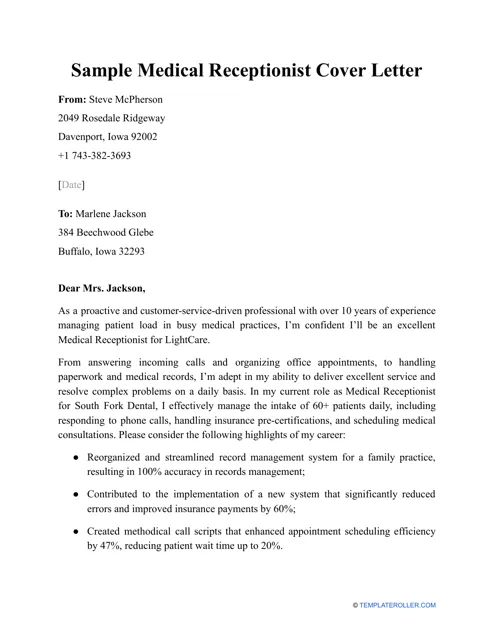
Before you start writing, research the healthcare facility and the specific role. Visit their website, read their mission statement, and understand their values. Look for any information about their patient care philosophy, technology used, and the overall environment. This research helps you tailor your cover letter to demonstrate your genuine interest in the company. Showing that you’ve taken the time to understand their needs shows initiative and that you are serious about the position. Make sure the medical receptionist cover letter example you are using as a guide aligns with your findings.
Addressing the Specific Requirements
Carefully read the job description and identify the key requirements. Then, in your cover letter, explicitly address each requirement. Use the same language as the job description to show that you understand what the employer is looking for. If the job emphasizes experience with a particular EHR system, highlight your proficiency in that system. If it values strong communication skills, provide examples of how you’ve excelled in patient communication. Tailoring your letter to the specific requirements ensures that you immediately grab the hiring manager’s attention, showing that you meet their expectations and are a good fit for the role.
Formatting and Presentation
Choosing the Right Tone and Language
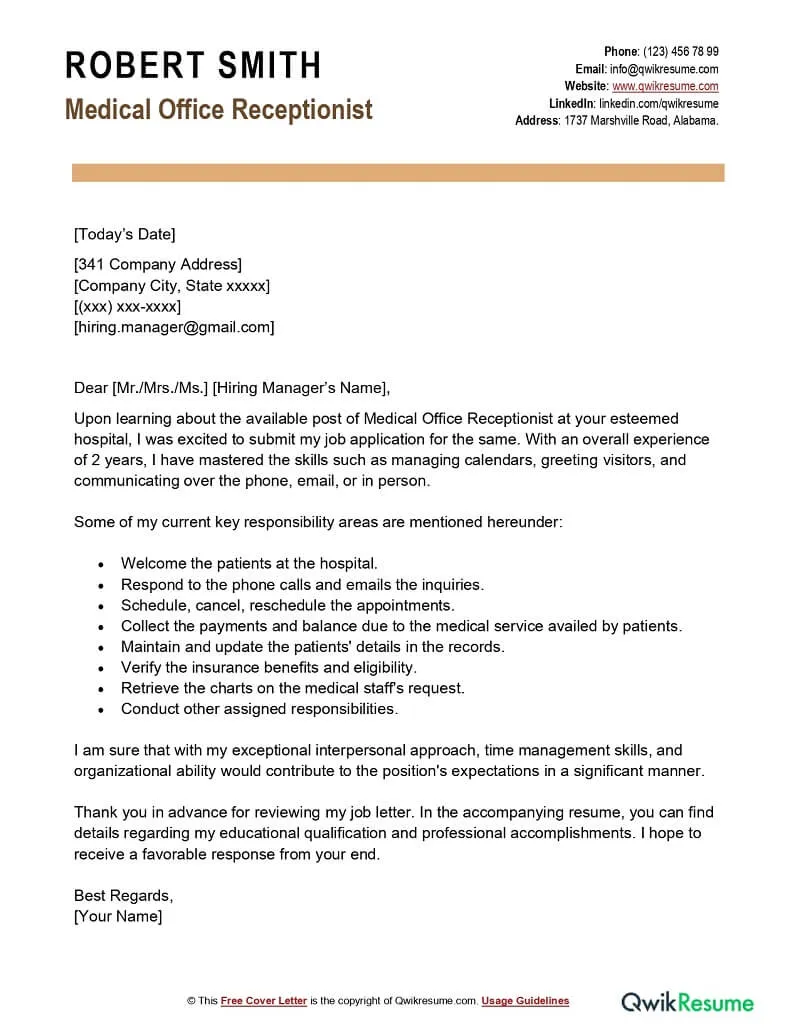
Maintain a professional yet friendly tone. Your cover letter should reflect your personality and allow the hiring manager to get a sense of who you are. Use positive and enthusiastic language. Avoid being overly formal or casual. Choose words that are appropriate for the healthcare environment. Focus on your ability to provide excellent patient care and be a supportive team player. When possible, tailor your language to match the tone of the company’s website and job posting. You want your cover letter to be professional, but also show your personality. Medical receptionist cover letter examples can guide you.
Proofreading and Editing
Before submitting your cover letter, meticulously proofread it. Check for spelling, grammar, and punctuation errors. These errors can undermine your credibility. Use a grammar checker or ask a friend or family member to review your letter. Ensure the formatting is consistent, with proper spacing and clear paragraphs. A well-edited cover letter demonstrates your attention to detail, which is crucial for a medical receptionist. Proofreading is non-negotiable. A few simple mistakes can cost you the chance of an interview. Check the medical receptionist cover letter example and avoid mistakes.
Common Mistakes to Avoid
Generic Content
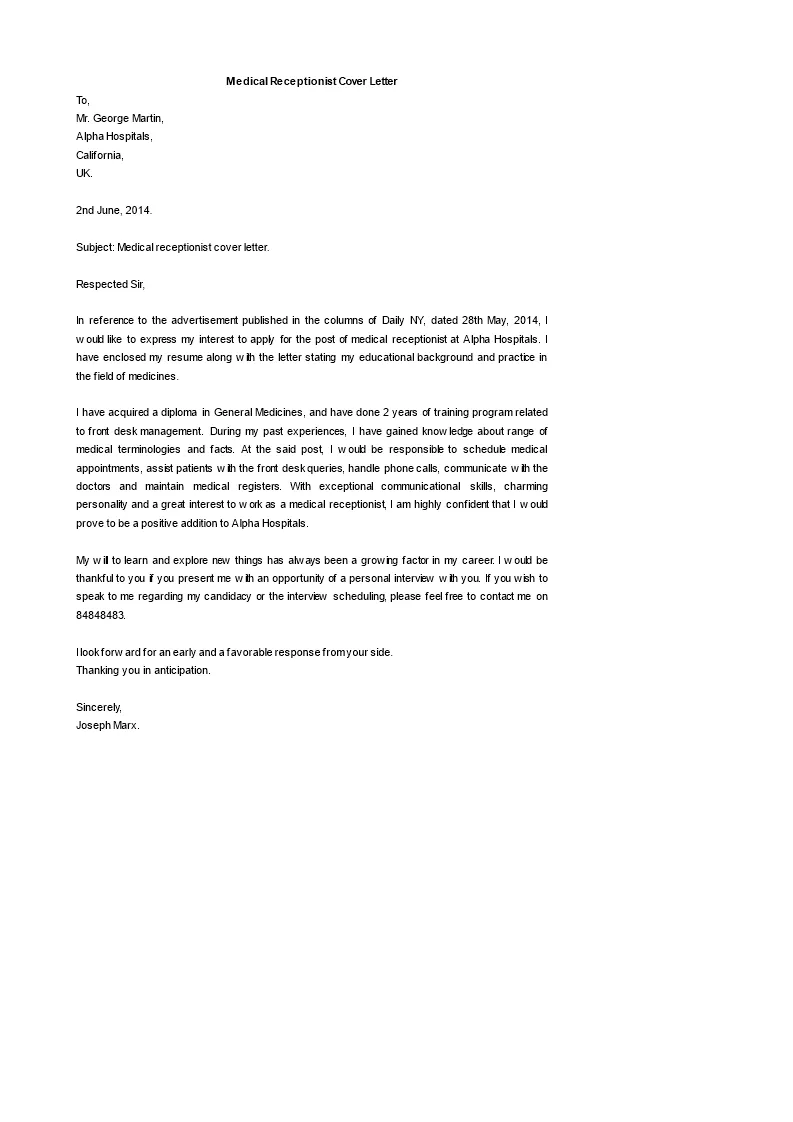
Avoid sending generic cover letters that could apply to any job. Tailor each letter to the specific role and the healthcare facility. Generic letters demonstrate a lack of interest and effort, which is a major turn-off for hiring managers. Highlight your skills and experience in ways that are specific to the job you are applying for, and tailor the letter to the company’s mission and values. Show that you have taken the time to research the company and understand their needs. Personalized letters make you stand out from other applicants.
Typos and Grammatical Errors
Typos and grammatical errors can damage your credibility. They show a lack of attention to detail, which is a critical skill for a medical receptionist. Thoroughly proofread your cover letter before submitting it. Use a grammar checker, and consider asking a friend or family member to review your letter for any errors you may have missed. Paying attention to detail in your cover letter is a signal to employers that you’re capable of doing the same in the workplace. Always check to ensure you have a correct medical receptionist cover letter example.
Closing and Call to Action
End your cover letter with a strong closing that summarizes your interest in the position and encourages the hiring manager to contact you. Reiterate your enthusiasm for the role and thank the hiring manager for their time and consideration. Include a call to action, such as “I am eager to discuss my qualifications further and can be reached at [phone number] or [email address].” Express your availability for an interview and reiterate your interest in the position. A well-crafted closing reinforces your key qualifications and leaves a positive lasting impression, encouraging the hiring manager to take the next step. This is an important part of any medical receptionist cover letter example.
In conclusion, a well-written cover letter is an essential part of your job application. By following these guidelines, you can create a compelling cover letter that effectively showcases your skills and experiences, increases your chances of getting an interview, and helps you land your dream job as a medical receptionist. Remember to tailor your cover letter to each job you apply for, and always proofread carefully. Good luck!
